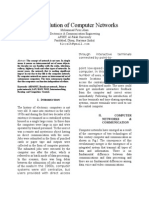0% found this document useful (0 votes)
45 views11 pagesHistory of Computer Networks
The document discusses the evolution of computer networks from the inception of ARPANET in the 1960s to modern advancements like optical fiber and Li-Fi technology. It highlights key milestones in networking history, including the development of protocols, the rise of the World Wide Web, and the emergence of wireless communication. The document emphasizes the significance of networking in today's digital landscape, showcasing its impact on communication and technology.
Uploaded by
Awais RanaCopyright
© © All Rights Reserved
We take content rights seriously. If you suspect this is your content, claim it here.
Available Formats
Download as PDF, TXT or read online on Scribd
0% found this document useful (0 votes)
45 views11 pagesHistory of Computer Networks
The document discusses the evolution of computer networks from the inception of ARPANET in the 1960s to modern advancements like optical fiber and Li-Fi technology. It highlights key milestones in networking history, including the development of protocols, the rise of the World Wide Web, and the emergence of wireless communication. The document emphasizes the significance of networking in today's digital landscape, showcasing its impact on communication and technology.
Uploaded by
Awais RanaCopyright
© © All Rights Reserved
We take content rights seriously. If you suspect this is your content, claim it here.
Available Formats
Download as PDF, TXT or read online on Scribd
/ 11






















































































